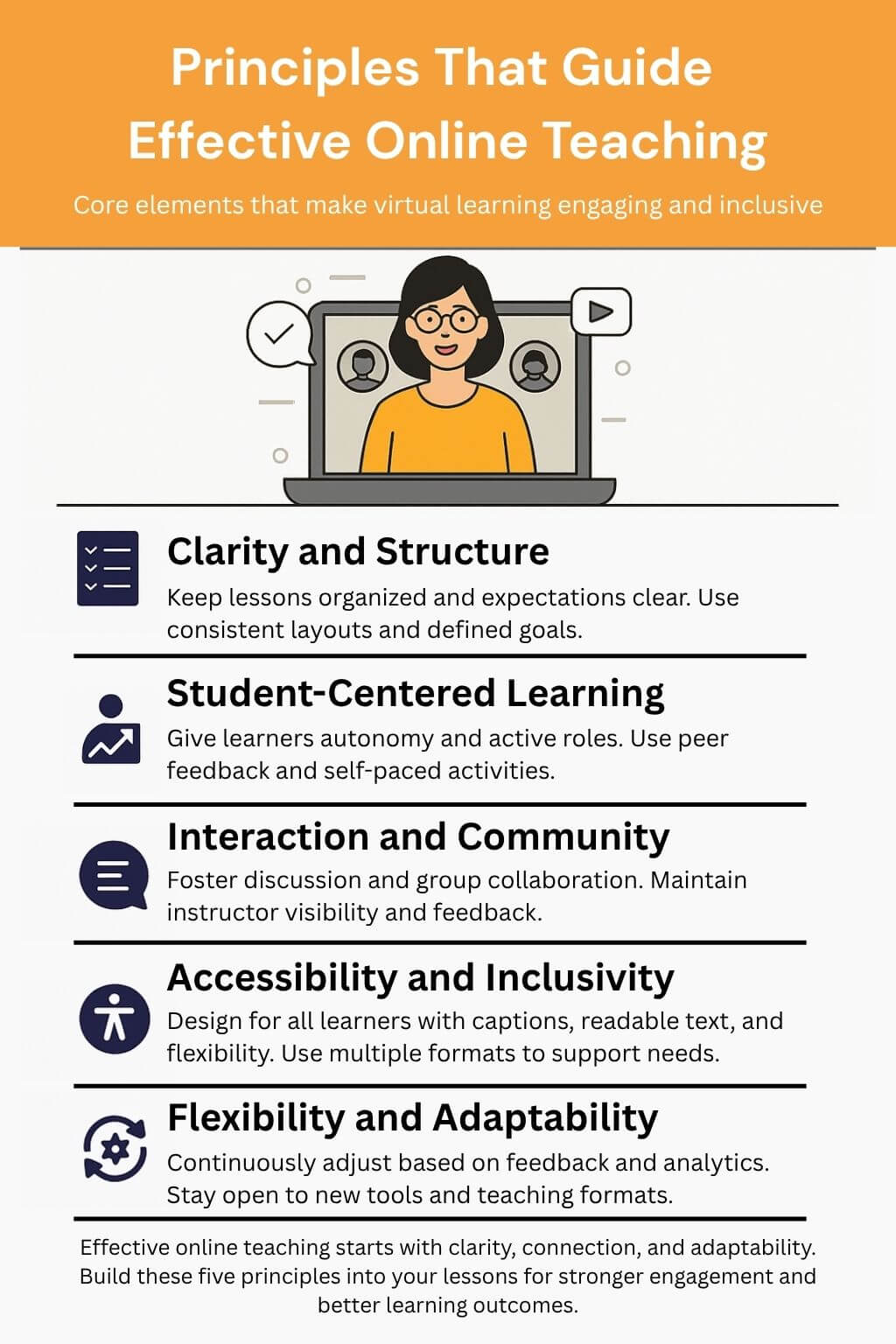



Online learning has transformed education by giving teachers and students the flexibility to connect and collaborate from anywhere. Beyond convenience, its real impact lies in how well it’s taught. Research shows that thoughtfully designed online teaching methods can improve student retention by as much as 60 percent compared to traditional classroom settings, a clear sign that effective strategy matters just as much as content.
Success in online education depends on more than digital tools. It requires intentional planning, engaging activities, and a structure that keeps learners motivated and focused. The following guide explores proven online teaching methods that help educators build interactive, inclusive, and results-driven virtual classrooms. Each approach emphasizes clarity, connection, and retention, the hallmarks of impactful e-learning.

Online teaching methods are organized strategies used to deliver lessons, encourage participation, and reinforce learning in digital environments. These teaching strategies online form the foundation of effective online pedagogy, helping educators create meaningful experiences that keep students actively engaged.
The choice of method directly shapes learning outcomes. When instructors align their approach with learner needs and course goals, they create spaces where students feel supported and involved.
Online teaching methods generally fall into three main categories:
Selecting the right method depends on your teaching philosophy, subject matter, and learner needs. A course emphasizing collaboration might use project-based learning, while one focused on knowledge mastery could rely more on microlearning or gamified lessons.

Behind every successful e-learning method or online teaching strategy lies a set of core principles that make virtual education more meaningful, inclusive, and sustainable. These foundations help educators move beyond simply transferring classroom lessons online, they guide how to design experiences that truly engage and support students.
Clarity builds confidence. Students learn more effectively when the structure of a course — objectives, expectations, and timelines — is easy to follow. Clear instructions, organized modules, and consistent layouts reduce confusion and cognitive load, allowing learners to focus on content rather than navigation. A well-structured digital classroom mimics the predictability of in-person learning but offers greater flexibility for students to learn at their own pace.
Effective online teaching revolves around student autonomy and active participation. Giving learners control over their pace, format, and interaction fosters a stronger sense of ownership. Techniques like self-assessment, peer feedback, and project-based assignments encourage engagement beyond surface-level comprehension. When students become co-creators of their learning journey, retention and motivation rise naturally.
Connection is a key predictor of success in online education. Students who feel part of a community are more likely to stay engaged and complete their courses. Interactive discussions, group activities, and social learning tools help replicate the social presence of a physical classroom. Regular feedback and instructor visibility, through short videos, announcements, or one-on-one check-ins, build trust and maintain motivation.
Every learner should be able to participate fully, regardless of ability or background. Accessibility features such as captioned videos, readable text formats, and screen-reader compatibility ensure inclusivity. In addition, flexible pacing and diverse content formats accommodate different learning preferences and time zones. Designing with inclusivity in mind not only meets accessibility standards but also enhances learning outcomes for everyone.
The best online teaching methods leave room for change. Technology evolves quickly, and so do learner needs. Effective instructors continuously evaluate engagement data, feedback, and performance metrics to adjust their approach. A flexible framework allows educators to introduce new tools, update materials, and adapt assessments without disrupting the course flow.

The success of online education relies not only on technology but also on how effectively educators apply proven teaching strategies. Below are key online teaching methods that promote engagement, retention, and meaningful learning experiences in digital classrooms.
The flipped classroom model reverses the traditional order of instruction. Instead of introducing new concepts during live sessions, students first study materials, such as videos, readings, or recorded lectures, on their own. Live class time is then used for discussion, collaboration, or applied exercises.
Why it works:
Tips for educators:
Project-Based Learning (PBL) and Problem-Based Learning (PrBL) place students at the center of their learning by challenging them to research, collaborate, and create solutions. These methods simulate real-world scenarios that encourage critical thinking and creativity.
Benefits include:
Tools to use: Trello, Miro, Notion, or Google Workspace for collaboration and project tracking.
Microlearning divides information into short, focused segments that learners can complete at their own pace. This approach works especially well for busy professionals or students balancing multiple commitments.
Why it’s effective:
Examples:
Best tools: TalentLMS, LearnWorlds, or a teleprompter app for concise video recording.
Static lectures often lose student attention. Interactive videos transform passive viewing into a participatory experience by embedding questions, clickable prompts, and reflection points within the lesson.
Why it engages learners:
Tools to consider: PlayPosit, Panopto, or H5P for interactive video creation.
Example strategy: Add short quizzes between video sections to reinforce key points and maintain attention.
Gamification applies game mechanics like points, levels, or badges to academic tasks. Game-based learning goes further, using actual games or simulations to teach concepts through play.
Benefits of gamified learning:
Examples and tools:
Key insight: Gamification leverages intrinsic motivation, learners find satisfaction in progress and achievement itself.
Learning thrives on interaction. Collaborative learning builds social connection through group projects, shared problem-solving, and peer review. It helps students learn from one another and develop real-world communication skills.
Advantages:
How to implement:

Adaptive learning uses AI and analytics to personalize the learning journey. The system analyzes student responses and automatically adjusts the difficulty, pace, or content sequence to fit individual needs.
Why it’s powerful:
Examples of adaptive tools: DreamBox, Smart Sparrow, Coursera’s adaptive quizzes
Application: A math student struggling with algebra gets additional practice questions, while an advanced learner progresses to geometry—all within the same system.
To create dynamic, inclusive, and engaging online courses that cater to diverse learning styles, educators should strategically combine various teaching methods. The most effective approach involves blending these methods based on specific learning goals, subject matter, and student needs, rather than relying on a single method.
These teaching strategies work even better when paired with the right digital tools. See our list of the best tools for online teaching to support your next lesson plan.

Technology alone doesn’t make online learning successful. What matters most is how educators apply digital teaching techniques that enhance clarity, confidence, and delivery. Teleprompter.com helps educators achieve all three by making it easier to record or present lessons naturally, without losing focus or momentum.
Here’s how it supports effective online teaching methods:
Educators using Teleprompter.com can simplify their recording process and improve how their lessons feel to learners.
Join educators using Teleprompter.com to deliver lessons that sound confident and connect with students.
Choosing the right online teaching methods isn’t about following trends. It’s about finding approaches that truly help students learn and stay engaged. The most effective methods balance structure, interaction, and flexibility while adapting to each learner’s pace and preferences.
Educators who combine thoughtful strategies with tools like Teleprompter.com can bring confidence and consistency to every lesson. By experimenting, gathering feedback, and refining techniques over time, teachers can create virtual classrooms that feel personal, effective, and lasting.
Building the right environment matters as much as the method. Learn how to create a professional and engaging space with our online teaching setup guide.
Online teaching methods are structured approaches educators use to deliver lessons virtually. Examples include flipped classrooms, gamification, project-based learning, and microlearning. These techniques are designed to improve engagement and knowledge retention.
Blended approaches that mix interactive video lessons, flipped classrooms, and collaborative activities tend to achieve the highest levels of engagement.
Start by defining your learning goals and understanding your audience. Microlearning fits short, skill-based lessons, while project-based learning works well for deeper exploration and real-world application.
Yes. When structured with clear rubrics and focused on performance-based tasks, online assessments can be highly reliable. Techniques like peer reviews and open-response projects help ensure fairness and authenticity.
Absolutely. Research shows that well-designed online courses can improve student retention rates by up to 60 percent compared to traditional classroom formats.



